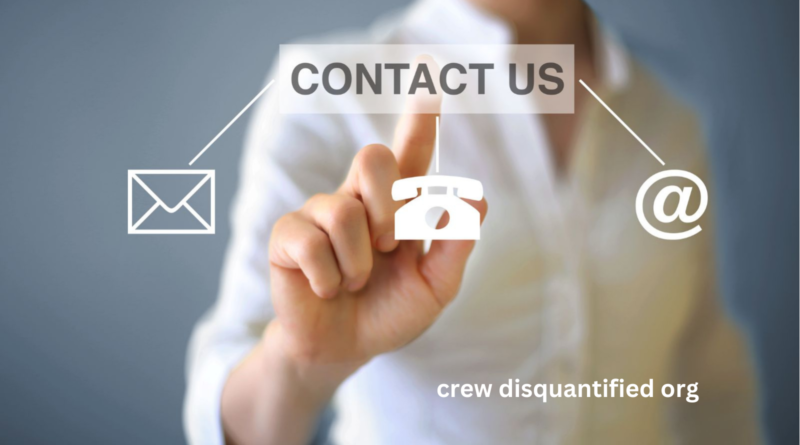Understanding Crew Disquantified Org: A New Paradigm in Team Dynamics
Introduction to Crew Disquantified Org
In today’s rapidly evolving work landscape, the term crew disquantified org is gaining traction. This concept fundamentally challenges traditional notions of team structure and performance measurement. As organizations shift towards more agile and adaptable frameworks, understanding the principles behind crew disquantified org becomes essential for fostering effective collaboration and innovation.
The idea of disquantification refers to moving away from rigid, quantitative metrics that often govern organizational performance. Instead, it emphasizes qualitative assessments and a more holistic approach to evaluating team dynamics. This article explores the implications of crew disquantified org, how it manifests in various environments, and the benefits it can bring to organizations aiming to thrive in a complex world.
The Rise of Disquantification in Organizational Contexts
Historically, organizations relied heavily on quantitative metrics to gauge success—think sales targets, productivity rates, and performance reviews. While these metrics have their place, they often fail to capture the nuances of team interactions and collaboration. The crew disquantified org model aims to shift this focus, advocating for a more integrative approach that considers the broader context of team dynamics.
Defining Crew Disquantified Org
At its core, a crew disquantified org emphasizes the importance of qualitative insights over rigid numerical data. This paradigm encourages teams to focus on the human aspects of collaboration, such as trust, communication, and shared goals. Rather than relying solely on performance indicators, organizations are encouraged to create environments where team members can express their creativity and expertise without being confined by quantifiable constraints.
The Need for Change
The changing nature of work, especially in the wake of the global pandemic, has highlighted the limitations of traditional metrics. Teams are often dispersed, working remotely, and facing new challenges that require adaptability. In this context, the crew disquantified org becomes particularly relevant. By shifting away from an over-reliance on numbers, organizations can foster a culture that prioritizes relationships and collaboration, leading to improved innovation and problem-solving capabilities.
Key Principles of Crew Disquantified Org
- Emphasizing Collaboration Over Competition
In a crew disquantified org, the focus shifts from competing against one another to working collaboratively. This environment encourages team members to share knowledge, support one another, and build upon each other’s strengths. - Valuing Qualitative Feedback
Rather than relying solely on numerical performance indicators, teams are encouraged to provide and seek qualitative feedback. This can take the form of peer reviews, open discussions, and constructive critiques that focus on growth and improvement. - Creating a Safe Space for Innovation
The crew disquantified org promotes a culture where team members feel safe to take risks and express their ideas without fear of failure. This is crucial for fostering creativity and innovation, as team members are more likely to share unconventional ideas when they feel supported. - Holistic Team Assessment
Instead of evaluating teams based on specific metrics, a crew disquantified org approaches assessment holistically. This might include considering team morale, engagement levels, and the overall impact of their work on the organization’s goals. - Adaptability and Flexibility
In a disquantified organization, teams are encouraged to remain adaptable and flexible in their approach to work. This is essential in a rapidly changing environment where new challenges and opportunities continually arise.
The Benefits of Adopting a Crew Disquantified Org Approach
Enhanced Team Dynamics
One of the most significant advantages of implementing a crew disquantified org model is the improvement in team dynamics. By fostering collaboration and open communication, organizations can create a more cohesive team environment. This leads to increased trust among team members, resulting in improved morale and productivity.
Increased Innovation
When team members feel safe to express their ideas and experiment without the pressure of quantifiable results, innovation flourishes. A crew disquantified org encourages out-of-the-box thinking, leading to unique solutions and creative problem-solving approaches.
Better Employee Engagement
Organizations that adopt a crew disquantified org model often see higher levels of employee engagement. Team members who feel valued for their contributions and are given the freedom to express themselves are more likely to be motivated and committed to their work.
Improved Retention Rates
By creating a supportive and collaborative environment, organizations can significantly enhance employee satisfaction. This, in turn, can lead to improved retention rates, as team members are less likely to seek opportunities elsewhere when they feel fulfilled and appreciated.
Implementing Crew Disquantified Org in Your Organization
1. Assess Your Current Culture
Before transitioning to a crew disquantified org, it’s essential to assess your current organizational culture. Identify areas where quantitative metrics dominate and consider how these might be balanced with qualitative insights.
2. Foster Open Communication
Encouraging open communication is vital for the success of a disquantified approach. Create channels for team members to share feedback, ideas, and concerns. Regular check-ins and team-building activities can help facilitate this process.
3. Provide Training and Resources
Equip your teams with the tools they need to succeed in a crew disquantified org. This might include training on effective communication, conflict resolution, and collaborative problem-solving techniques.
4. Celebrate Successes
Recognizing and celebrating team achievements, both big and small, can reinforce the value of collaboration over competition. This not only boosts morale but also encourages team members to continue working together effectively.
5. Continuously Evolve
The transition to a crew disquantified org is not a one-time event but an ongoing process. Regularly evaluate your approach and seek feedback from team members to ensure that the organization continues to foster a collaborative and supportive environment.
Challenges of the Crew Disquantified Org Model
While the crew disquantified org model presents numerous benefits, it’s not without its challenges. Organizations may encounter resistance from those accustomed to traditional metrics. It can be difficult to shift mindsets and ingrained practices, especially in established organizations.
Overcoming Resistance
To successfully implement a crew disquantified org, it’s crucial to address resistance head-on. Provide clear explanations for the shift and the potential benefits for both individuals and the organization as a whole. Engage team members in the process and encourage them to voice their concerns.
Maintaining Accountability
Without traditional metrics, some may worry about accountability and performance tracking. To address this, organizations can develop new frameworks for evaluating team effectiveness that incorporate qualitative assessments alongside more traditional measures.
The Future of Crew Disquantified Org
As the workplace continues to evolve, the principles of crew disquantified org are likely to become even more relevant. Organizations that prioritize collaboration, innovation, and holistic assessment will be better positioned to navigate the complexities of the modern work environment.
A Shift in Leadership Mindset
For the crew disquantified org model to thrive, a shift in leadership mindset is necessary. Leaders must embrace the idea that their role is to foster a collaborative environment rather than merely enforcing performance metrics. This involves leading by example and creating spaces where team members feel empowered to share their ideas and take risks.
Embracing Technology
Technology will also play a critical role in the future of crew disquantified org. Tools that facilitate communication, collaboration, and project management can support the disquantified approach, enabling teams to work more effectively and efficiently.
Final Thoughts
The crew disquantified org model represents a significant shift in how organizations approach teamwork and performance assessment. By emphasizing collaboration, innovation, and qualitative insights, organizations can create environments that foster creativity and engagement.
As you consider implementing this model in your organization, reflect on the following questions:
- How can your organization create a culture that values qualitative feedback?
- What steps can you take to foster open communication and collaboration among team members?
- How can technology support your transition to a crew disquantified org?
By embracing the principles of crew disquantified org, organizations can position themselves for success in a dynamic and ever-changing world.
Sources
- Harvard Business Review: The Importance of Qualitative Feedback
- Forbes: The Future of Work and Team Dynamics
- McKinsey & Company: Organizational Change in the Modern Workplace
4o mini




